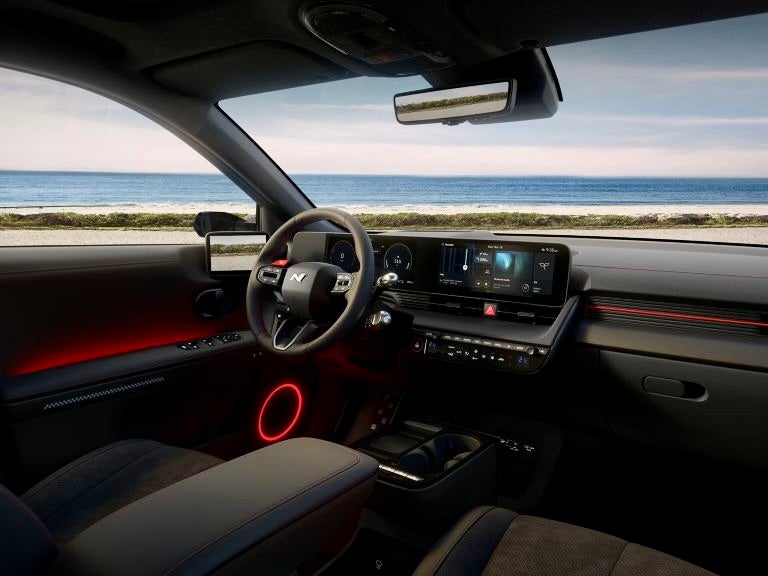
Where so many cars from the same company all look the same, Hyundai has taken a different approach. It says that its cars may come from the same family, but they’re more like chess pieces so have different looks and serve different purposes.
That means the Hyundai Ioniq 5 – the first of the new breed of Ioniq models, despite the number 5 in its name – looks very different to the Ioniq 6 ‘streamliner’, while the seven-seat Ioniq 9 (another strange bit of naming) will get another unique look.
The good news is they all look fabulous and are the combined work of Hyundai’s Korean former-Bentley designer Sangyup Lee as design chief and Brit Simon Lousby who runs the Hyundai design studio. However, the Ioniq 5’s appeal is far more than skin deep – it’s a great all-rounder that was good enough to win the title of World Car of the Year in 2022.
It’s still a brilliant car today and a great all-rounder with a combination of efficiency, quality, technology and practicality. It’s also a really comfortable car to drive with good visibility and excellent ride comfort, while the new 84kWh battery means a maximum claimed range of 354 miles, with fast charging for a 10 to 80 per cent change in just 18 minutes.
Talking of fast, if you fancy something a bit more fun, there’s the Ioniq 5 N – a truly groundbreaking EV hot hatch.
How we test
We lived with the revised Ioniq 5 for a week recently, covering long distances with family on board and shorter local runs on all sorts of road surfaces. However, since the Ioniq 5 was launched in 2021 we’ve tested it over many thousands of miles.
Hyundai Ioniq 5: From £39,900, Hyundai.com

Independent rating: 9/10
Battery, range, charging and performance
The new 84kWh battery means that an already decent range has been improved – and as with all Hyundai models, the range claims are more realistic than most with excellent efficiency. Opt for the rear-drive entry-level Advance model with the 84kWh battery and you could go for 354 miles between charges. Moving up the range through Premium, N Line, Ultimate and N Line S, and adding all-wheel drive, sees the range drop, but all models with the bigger battery will do well over 300 miles.
The cheapest Advance and Premium models can be bought with 63kWh batteries with a still decent maximum claimed range of 273 miles. All models take advantage of the Hyundai Group’s 800-volt platform technology so get 260kW fast charging with a 10 to 80 per cent charge at a suitable rapid charger taking just 18 minutes. A standard heat pump across the range improves efficiency in all models, too.
The all-wheel drive cars with the bigger batteries are the fastest with an impressive 0-62mph time of just 5.3 seconds, although all Ioniq 5s feel reasonably quick. Check out the brilliant Ioniq 5 N, though, if you want to know how exciting an all-electric hot hatch can be.
Likewise, the handling on all models is good – the steering feels beefy and communicative, there’s little body lean through corners and plenty of grip. And on most roads the ride is perfectly reasonable.
Interior, practicality and boot space
Having a flat floor in an EV pays real dividends when it comes to interior space. Whether you’re in the front or the back of an Ioniq 5, you’ll have plenty of leg and head space, and the width of the car pays dividends, too.
The window line is quite high so you don’t necessarily get the greatest view out, but the sliding centre console can free up a bit more space in between the front seats at the front or back wherever you choose to put it. The rear doors open nice and wide for easy access.
There are enough buttons around to be able to control all the important settings without over-reliance on the touchscreen – something rivals would do well to copy – while major controls including the gear selector are all intuitive to find and use. The use of sustainable materials in a cool-looking cabin give the car a really premium feel.
The boot, at 520 litres, is an excellent size and will hold at least a couple of suitcases, while folding the rear seats down for a trip to the recycling centre gives you 1,580 litres of space. There’s also some additional space for storage under the bonnet.

Technology, stereo and infotainment
A couple of minor changes mean a lot to the technology inside. The twin 12.3-inch screens for driver display and infotainment have a dark surround to reduce reflections, while Apple CarPlay and Android Auto connectivity is now wireless – so you can make more use of the wireless charging pad, too.
There’s plenty for tech fans to get stuck into in the Ioniq 5 from a smartphone app to control the charging and air-con to slim digital side mirrors with cameras that display their feed to screens at each end of the dash – they’re said to improve aerodynamics and, therefore, efficiency. The rear-view mirror can also be switched to a feed from a rear-facing digital camera.
There’s Vehicle to Load (V2L) tech on board so you can plug in and run anything with a three-pin plug, while even the rear seats can be powered. All the expected safety systems with their own acronyms are present and correct.
Music fans will enjoy the Bose audio system that provides a crisp and punchy sound.
Prices and running costs
Although the entry-level Ioniq 5 comes in at just under the £40,000 mark that brings with it more in the way of car tax, the rest of the range is still quite pricey, although zero per cent finance and deposit contributions are often available across the range.
We’ve always been pleasantly surprised by electric Hyundai’s abilities to get close to the predicted range on the car’s read-out – sometimes even exceeding the expected range. The same applies to the Ioniq 5, while running costs otherwise are par for the EV course.

Hyundai Ioniq 6 rivals:
FAQs
How much does Ioniq 5 cost and is it worth it?
The entry-level Ioniq 5 is well-priced at £39,990 but that comes with the smaller battery. The rest of the range is reasonably well-priced, with the added attraction of zero per cent finance offers and deposit contributions for finance.
How long does it take to charge?
On a suitable ultra-fast charger, the Ioniq 5 can charge at 260kW so the battery can get a 10 to 80 per cent charge in just 18 minutes.
Does Hyundai replace batteries for free?
Hyundai covers its electric car for eight years and 100,000 miles, while the main Hyundai warranty provides cover for an impressive five years.
The verdict: Hyundai Ioniq 6
In a world without Tesla, the Hyundai Ioniq 5 could well vie for the title of best all-round EV – it really is that good. The recent round of updates has addressed the few issues we – and owners – have had with the car, including the not inconsiderable point of adding a rear wiper!
The Ioniq 5 has always looked great – fresh and new, without looking wacky – while the interior balances advanced tech with a degree of class and restraint, while still looking super-modern. The latest model very mildly improves both.
The looks of the car can be somewhat deceiving. When you see it in the metal, it’s actually bigger than you might think it is – it’s quite a wide car. However, that pays dividends inside where there is a huge amount of space with a flat floor that makes both the front and the back feel roomier than some rivals.
A bigger battery in the latest car extends the maximum claimed range to over 350 miles, with the published efficiency figures actually being achievable in the real world.
What hasn’t changed is the easy-natured drive with a comfortable ride, excellent performance and safe, secure handling, too.







